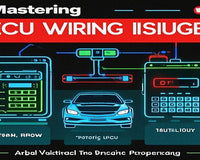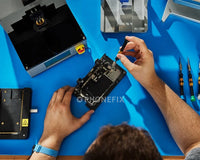Water ingress in a vehicle's Engine Control Unit (ECU) is a nightmare for any car owner. The ECU, often called the "brain" of the car, controls countless critical functions, from fuel injection to ignition timing. When water seeps in, it can cause short circuits, corrosion, and permanent damage to sensitive components. If your vehicle feels sluggish and unresponsive, it’s essential to check for potential water damage to the ECU.
Step 1: Identify and Assess the Damage.
Look for any signs of water inside the ECU housing or connector. Look for rust or corrosion on the circuit board, connectors, and other components. Common symptoms of ECU water damage include erratic engine behavior, unresponsive controls, warning lights flashing randomly, or the car failing to start altogether.
Step 2: Remove and Disassemble the ECU.
Carefully disconnect the ECU from the vehicle and remove it. Use a soft cloth to gently wipe away any visible water and moisture.
Step 3: Clean the Components.
Water often leaves behind corrosive residues, so thorough cleaning is crucial. Use isopropyl alcohol (90% or higher) and a soft brush to clean the circuit board. Pay special attention to car chips, these tiny, powerful semiconductors control specific functions and are highly sensitive to corrosion.
Step 4: Inspect for Damage.
After cleaning, inspect the circuit board for signs of severe damage. Look for burnt components, cracked traces (the thin copper lines on the board), or swollen capacitors. If you find burnt chips or broken traces, these will need to be replaced.
Step 5: Replace Faulty Parts.
If car chips are damaged, you’ll need to replace them.
For damaged traces, you can repair them using a fine wire and soldering iron, bridging the broken sections. Replace any swollen or leaking capacitors with ones of the same voltage and capacitance rating.
Step 6: Test with an ECU Programmer.
Once repairs are complete, you’ll need to verify that the ECU functions correctly. KT200 Plus ECU programmer is an essential tool here. It connects to the ECU and allows you to read, write, and test the unit’s software. Use the programmer to check for error codes and ensure the ECU can communicate with the car’s other systems.
Step 7: Reassemble and Reinstall.
After testing confirms the ECU works, reassemble the housing, ensuring all seals are intact to prevent future water ingress. Reinstall the ECU, reconnect the battery, and start the car. Monitor for any issues. if problems persist, double-check your repairs or consult a professional.
Take preventive measures and regular vehicle inspections can help prevent problems.
Check door and window seals regularly for cracks.
Ensure drain holes in the car’s body.
Avoid driving through deep water – even a few inches can splash into vulnerable areas.
Consider waterproofing the ECU housing with a sealant (ensure it’s heat-resistant and doesn’t interfere with ventilation).
Understanding the symptoms of a water-damaged ECU is essential for any vehicle owner. These symptoms, such as engine misfires, starting issues, warning lights and erratic behaviour, can signal significant underlying problems. 
To maintain your vehicle’s performance, reliability and safety, stay vigilant. Regular maintenance and prompt attention to any signs of ECU damage can save you from extensive repairs and keep your vehicle running smoothly.
How to Repair Vehicle ECU Water Ingress?










